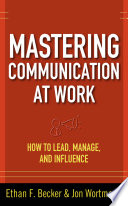

Effective communication is the cornerstone of successful leadership and management. It encompasses not only the ability to convey information clearly but also the capacity to listen actively and empathetically. This idea emphasizes that leaders must be adept at both sending and receiving messages. The book outlines various communication styles and techniques that can enhance clarity and understanding in the workplace. It also discusses the impact of non-verbal communication, tone, and context, highlighting how these elements can either bolster or undermine a message. By mastering these aspects, leaders can foster a more inclusive and collaborative work environment, ultimately leading to improved team performance and morale.
Continue readingTrust and credibility are essential for effective communication in any organizational setting. The book delves into the mechanisms through which leaders can build trust with their teams, such as transparency, consistency, and integrity. It discusses the importance of following through on commitments and being open about challenges and limitations. Additionally, the text explores how leaders can cultivate a culture of trust within their teams, encouraging open dialogue and feedback. When trust is established, team members are more likely to share ideas, voice concerns, and collaborate effectively, leading to a more dynamic and innovative workplace.
Continue readingDifferent individuals have varying communication preferences and styles. The book emphasizes the importance of recognizing these differences and adapting one's communication approach accordingly. It introduces concepts such as the DISC model, which categorizes people into four primary communication styles: Dominance, Influence, Steadiness, and Conscientiousness. By understanding these styles, leaders can tailor their messages to resonate with their audience, thereby enhancing understanding and engagement. This adaptability not only improves interpersonal relationships but also facilitates conflict resolution and negotiation, as leaders can navigate discussions more effectively by aligning their style with that of their counterparts.
Continue readingFeedback is a critical component of effective communication and is essential for personal and professional growth. The book discusses how leaders can create an environment where feedback is encouraged and valued. It outlines strategies for giving constructive feedback that is specific, actionable, and delivered in a timely manner. Additionally, the text emphasizes the importance of receiving feedback gracefully and using it as a tool for self-improvement. By fostering a feedback-rich culture, organizations can enhance performance, drive innovation, and empower employees to take ownership of their development.
Continue readingInfluence and persuasion are vital skills for leaders who wish to motivate their teams and drive change. The book outlines various techniques for effectively influencing others, including the use of storytelling, emotional appeals, and logical reasoning. It discusses the importance of understanding the audience's needs and values, as well as the ethical considerations involved in persuasion. By mastering these techniques, leaders can inspire action and commitment, rallying their teams around a shared vision and objectives.
Continue readingDifficult conversations are an inevitable part of leadership and management. The book provides strategies for approaching these conversations with confidence and empathy. It emphasizes the importance of preparation, active listening, and maintaining a calm demeanor during discussions. Additionally, the text highlights the need for leaders to remain solution-focused and to seek common ground, even in challenging situations. By developing the skills to navigate difficult conversations, leaders can resolve conflicts more effectively and strengthen relationships within their teams.
Continue readingIn today's digital age, technology plays a significant role in workplace communication. The book discusses various tools and platforms that can enhance communication and collaboration among team members, such as video conferencing, instant messaging, and project management software. It also addresses the challenges posed by digital communication, including misinterpretation and information overload. The text offers guidance on how to use technology effectively while maintaining a human touch, ensuring that communication remains clear and personal despite the medium.
Continue reading